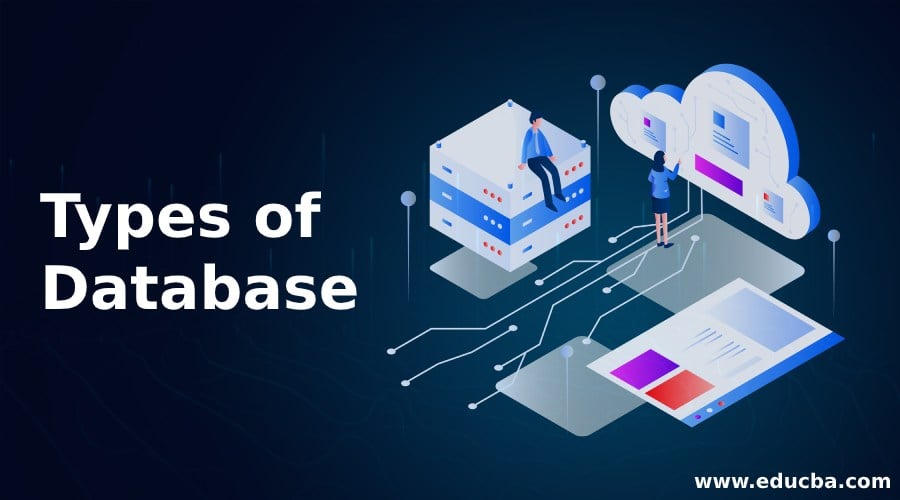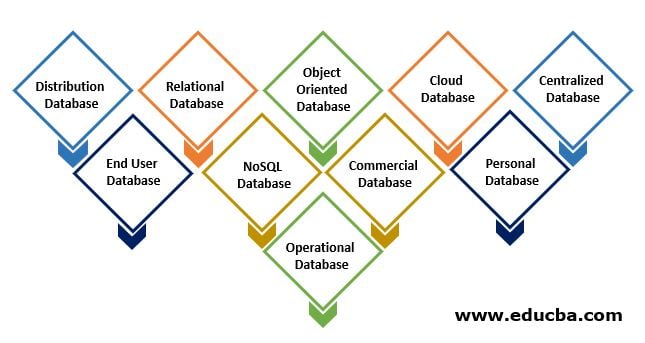Updated July 6, 2023
Introduction to Types of Database
Basically, databases are data warehouses. Since we also have a book store in a public library, we can assume that a database of books is a library. However, closely defined, databases are computer frameworks that store, organize, protect and supply data. A database system is referred to as a system for the management of a database or DBM. In this topic, we are going to learn about Types of Database.
Different Types of Database
The following types of databases are available on the market, depending on the application requirements:
1. Distribution Database
In comparison to the centralized database idea, there are inputs from the general database and the information collected from local computers. The data is not accessible in a single location and is distributed to various company sites. These sites are connected to each other through communication links that enable access to the data distributed.
A distributed database in which various parts of a database are located in different physical locations, along with databases replicated and distributed between different points in a network can be imagined. Heterogeneous and homogenous are the two kinds of distribution databases. Databases with the same base hardware running on the same operating systems and applications are known as homogeneous DDBs. In different sites of the DDB, defined as a heterogeneous DDB, operating systems, the underlying hardware and application procedures can be different.
2. Relational Database
Such databases are classified by a set of tables, in which data falls into a predefined classification. The table is made up of rows and columns with data input for a certain category and rows, with the example of the data identified by the category. The Structured query language is the standard interface of a relation-database user and application program. Several basic operations can be added to a table that enable the expansion of these databases, joining two commonly-related databases and modifying all existing applications.
3. Object Oriented Database
An object-driven database is an object-driven and relational database collection. Different items, such as java and C++, can be saved in a relational database using object-oriented programming languages, but object-oriented databases are suitable for these components. An object-oriented database will be organized instead of actions around objects and data instead of logic. In contrast to an alphanumeric value, a multimedia record in a relational database can be a definable data object.
4. Cloud Database
Now a day, data are stored in a public cloud, a hybrid cloud or a private cloud, also known as a virtual environment. A cloud database is an automated or built-in database for such a virtualized environment. A cloud service offers various advantages, including the ability to pay per user storage capacity and bandwidth and provides scalability on request and high availability. In addition, a cloud platform allows companies to support enterprise applications in delivering software as a service.
5. Centralized Database
The data is stored centrally and users from various locations can access this data. This database includes hiring processes that help users access the data from a remote location. For verification and validation of end-users, various types of authentication procedures are applied, and the application processes keep track and record data utilization and provide registration numbers.
6. End User Database
The end-user is generally not worried about purchases or transactions at different levels and only understands the commodity, a program, or an application. It is, therefore, a collaborative database designed specifically for the end-user, as do the managers at various levels. This database offers a list of all the details.
7. NoSQL Database
These are used for large data sets. Certain big data performance problems are handled effectively by relational databases, and NoSQL databases can easily address such problems. The analysis of large-size, unstructured information can be done very efficiently on several cloud virtual servers.
8. Commercial Database
These are the paid versions of the enormous databases designed for users who wish to access the information for assistance. These databases are specific subjects, and such huge information can not be maintained. Commercial links provide access to such databases.
9. Personal Database
Data is collected and stored on small and easily manageable personal computers. The data are usually used by the same company department and are viewed by a small number of individuals.
10. Operational Database
In this folder, information on a company’s operations is stored. These databases are needed for functional lines such as marketing, employee relationships, customer service, etc.
Conclusion
In this article we have seen different types of databases and how do they work. You can choose any type of database or combination of databases based on your requirements.
Recommended Articles
This is a guide to Types of Database. Here we have discussed the basic concept and top 10 types of database in a descriptive manner. You may also have a look at the following articles to learn more –


